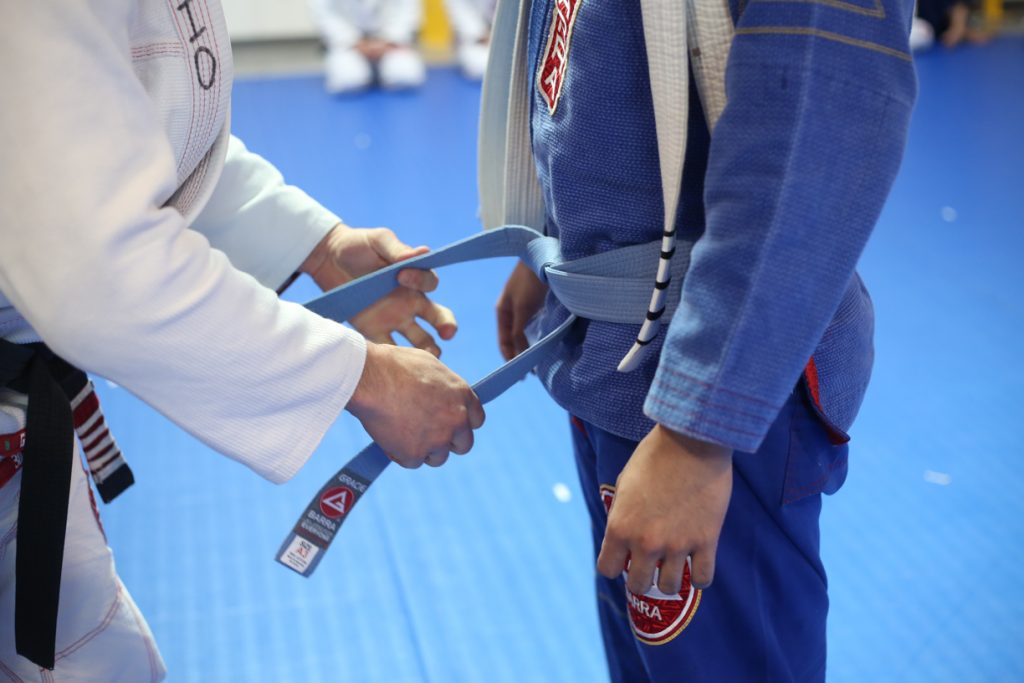The Difference Between The Belts

“What is the difference between a blue belt and a purple belt?” someone asked. What about a purple belt and a brown or black belt?
There is definitely a difference in the technique vocabulary between a white belt and the colored belts. The time spent at white belt and into blue belt is largely learning the various main techniques for each position and the correct mechanics. Yet after several years training jiu-jitsu most students have seen the majority of techniques that they will need to know to become a brown or black belt. It is not the volume of techniques that one knows that separates the purple belt from the brown belt. For instance we don’t say “The purple belt only knows the De la Riva sweeps A, B and C while the brown belt also knows sweeps D and E.” At any jiu-jitsu tournament we can witness blue belts effectively using some advanced positions. It is not about the techniques.
So what IS the difference between the colored belts if it is not in the specific techniques that they use?
Movement and connecting the positions are 2 of the significant, but less tangible differences.
Movement is the ability to enter into your sweeps and submissions with speed and precision, without using too much strength or wasted effort. Recognizing an opportunity and moving seamlessly to the next position.
I use the example that a muay thai coach explained to me as it applies to jiu-jitsu as well.
We have 3 boxers: a 1st year boxer with some training, an amateur fighter with several years of experience and a high level professional fighter. We watch them solo shadow boxing, only watching the fluidity, smoothness and crispness of their movements without an opponent. There is no opponent or measurement of punching power, yet we can SEE the differences in movement. It is different to quantify, but we know it when we see it.
How do we get that brown and black belt quality of movement? The simple but honest answer is experience. Hundreds of hours of mat time.
Connecting the positions. This is a very big but less concrete aspect to define. Like a chess master using the identical board and pieces as his novice opponent, the higher belts see the larger picture of the match and how one position connects to the later positions. That way they are able to “see” moves 5 moves ahead of the opponent.
When a jiu-jitsu fighter has the experience to connect the seemingly unconnected positions on the ground, they are able to recognize, anticipate and react in a fraction of a second to their opponents actions in a fast paced match. They use this ability to get ahead of the opponent and are able to fight from an advantaged position.
If we return to the boxing analogy, we don’t see striking matches won because a boxer comes out with a single, huge punch that the opponent has never seen before. Instead, the better fighter uses combinations and counter punching strategies to overcome the defense of the opponent. Both of these concepts can be seen as connecting your positions and techniques in a similar way that the jiu-jitsu student connects their choke to sweep to arm bar attacks.
So how do we develop this ability to connect our positions?
I am going to give the same advice that your instructor likely gives when you ask “What can I do to get better at jiu-jitsu?”
“Just keep showing up” they reply. Now this might seem like an unsatisfying answer, but it is also the true answer. There is no substitute for mat time, repetitions and experience to develop your movement and ability to connect your positions.
See also on Gracie Barra : What Does a Black Belt Work On In Training?
Credits: Mark Mullen
Gracie Barra Black belt based in Asia
Instagram: @markmullen.bjj
